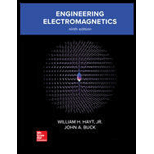
Engineering Electromagnetics
9th Edition
ISBN: 9780078028151
Author: Hayt, William H. (william Hart), Jr, BUCK, John A.
Publisher: Mcgraw-hill Education,
expand_more
expand_more
format_list_bulleted
Textbook Question
Chapter 13, Problem 13.8P
A transmission line constructed from perfect conductors and an air dielectric is to have a maximum dimension of 8 mm for its cross section. The line is to be used at high frequencies. Specify the dimensions if it is (a) a two-wire line with
Expert Solution & Answer
Want to see the full answer?
Check out a sample textbook solution
Students have asked these similar questions
Please answer 1, 2 and 3 on the end
Please answer 1 and 2 on the end
Determine the figure of merit for both DSB AM and FM, provided that the modulating signal is a single-tone signal.
Chapter 13 Solutions
Engineering Electromagnetics
Ch. 13 - The conductors of a coaxial transmission line are...Ch. 13 - Prob. 13.2PCh. 13 - Prob. 13.3PCh. 13 - Find R, L, C, and G for a two-wire transmission...Ch. 13 - Prob. 13.5PCh. 13 - Consider an air-filled coaxial transmission line...Ch. 13 - Pertinent dimensions for the transmission line...Ch. 13 - A transmission line constructed from perfect...Ch. 13 - Prob. 13.9PCh. 13 - Two microstrip lines are fabricated end-to-end on...
Ch. 13 - Prob. 13.11PCh. 13 - Prob. 13.12PCh. 13 - Prob. 13.13PCh. 13 - Prob. 13.14PCh. 13 - For the guide of Problem 13.14, and at the 32 GHz...Ch. 13 - Prob. 13.16PCh. 13 - A parallel-plate guide is partially filled with...Ch. 13 - Prob. 13.18PCh. 13 - Prob. 13.19PCh. 13 - Two rectangular waveguides are joined end-to-end....Ch. 13 - Prob. 13.21PCh. 13 - Consider the TE11 mode in a rectangular guide...Ch. 13 - Prob. 13.23PCh. 13 - Prob. 13.24PCh. 13 - Prob. 13.25PCh. 13 - Prob. 13.26PCh. 13 - Prob. 13.27PCh. 13 - Prob. 13.28PCh. 13 - An asymmetric slab waveguide is shown in Figure...Ch. 13 - A step index optical fiber is known to be single...Ch. 13 - Prob. 13.31PCh. 13 - Prob. 13.32P
Knowledge Booster
Learn more about
Need a deep-dive on the concept behind this application? Look no further. Learn more about this topic, electrical-engineering and related others by exploring similar questions and additional content below.Similar questions
- + Preemphasis LHS R signal L RHS signal Frequency doubler Pilot tone (a) + Preemphasis Composite baseband spectrum L+R Pilot tone L-R (DSB-SC) + FM modulator f (kHz) (b) 15 19 23 38 53 Lowpass filter Deemphasis + L Audio amplifier FM discriminator Narrowband filter Frequency doubler Bandpass R Audio ✗ Deemphasis + filter amplifier (c) and (c) FM stereo receiver. FIGURE A.25 FM stereo broadcasting: (a) FM stereo transmitter, (b) spectrum of FM stereo signal,arrow_forward4-3) Similar to Lathi & Ding, Prob. P.4.2-3 For a DSB-SC signal g(t) = 2m(t)cos(4000) transmitting each of the following messages, (a) write an expression for G(f) and (b) sketch the magnitude spectrum |G(f)], specifying the FWHM (full width at half-maximum) of any spectrum peaks. a) m(t) = sinc²(100-50л) b) m(t)=400e-80,000r²arrow_forward4-2) Lathi & Ding, similar to problem 3.8-5. For the filter shown below, with an input signal whose PSD is given by S⭑(f) = П(0.25лf): (a) Find the total input power; (b) Find the transfer function H(f); (c) Find the power spectral density (PSD) of the output signal; (d) Find the total output power of the signal 500 ΚΩ d 1 µF dt y(t)arrow_forward
- 4-1) Distortionless transmission A bandpass signal g(t) of bandwidth B = 2000 Hz centered at f= 5.0x104 Hz is passed through the RC filter below with RC = 4.0x105 radians/s. If over the passband, a variation of less than 2% in both amplitude response and time delay is considered to be distortionless transmission, would g(t) be transmitted without distortion? Find the approximate magnitude response and the approximate time delay for the signal. R w g(1) y(t)arrow_forwardFundamentals Of Energy Systems THQ1 Q6arrow_forwardA single phase has two group A and B, 50 Hz, overhead line system has radius of conductor 0.5 cm. alculate the total inductance of the line. a2 a1 6 cm 2 m 3m b₂ m B b₁arrow_forward
- A single phase has two group of conductors A & B; where A consists of 3- sub conductors (a, b, c) each of its have a radius of 0.25 cm, and the group B consists of two sub conductors (d, e) each of its have a radius of 0.5 cm. Calculate the inductance of the total system where the distance between the sub conductors is as below. 9m 6m 6m ୦୩ Group A Group Barrow_forwardFundamentals Of Energy Systems THQ1 Q8arrow_forwardFundamentals Of Energy Systems THQ1 Q7arrow_forward
arrow_back_ios
SEE MORE QUESTIONS
arrow_forward_ios
Recommended textbooks for you
 Introductory Circuit Analysis (13th Edition)Electrical EngineeringISBN:9780133923605Author:Robert L. BoylestadPublisher:PEARSON
Introductory Circuit Analysis (13th Edition)Electrical EngineeringISBN:9780133923605Author:Robert L. BoylestadPublisher:PEARSON Delmar's Standard Textbook Of ElectricityElectrical EngineeringISBN:9781337900348Author:Stephen L. HermanPublisher:Cengage Learning
Delmar's Standard Textbook Of ElectricityElectrical EngineeringISBN:9781337900348Author:Stephen L. HermanPublisher:Cengage Learning Programmable Logic ControllersElectrical EngineeringISBN:9780073373843Author:Frank D. PetruzellaPublisher:McGraw-Hill Education
Programmable Logic ControllersElectrical EngineeringISBN:9780073373843Author:Frank D. PetruzellaPublisher:McGraw-Hill Education Fundamentals of Electric CircuitsElectrical EngineeringISBN:9780078028229Author:Charles K Alexander, Matthew SadikuPublisher:McGraw-Hill Education
Fundamentals of Electric CircuitsElectrical EngineeringISBN:9780078028229Author:Charles K Alexander, Matthew SadikuPublisher:McGraw-Hill Education Electric Circuits. (11th Edition)Electrical EngineeringISBN:9780134746968Author:James W. Nilsson, Susan RiedelPublisher:PEARSON
Electric Circuits. (11th Edition)Electrical EngineeringISBN:9780134746968Author:James W. Nilsson, Susan RiedelPublisher:PEARSON Engineering ElectromagneticsElectrical EngineeringISBN:9780078028151Author:Hayt, William H. (william Hart), Jr, BUCK, John A.Publisher:Mcgraw-hill Education,
Engineering ElectromagneticsElectrical EngineeringISBN:9780078028151Author:Hayt, William H. (william Hart), Jr, BUCK, John A.Publisher:Mcgraw-hill Education,

Introductory Circuit Analysis (13th Edition)
Electrical Engineering
ISBN:9780133923605
Author:Robert L. Boylestad
Publisher:PEARSON

Delmar's Standard Textbook Of Electricity
Electrical Engineering
ISBN:9781337900348
Author:Stephen L. Herman
Publisher:Cengage Learning

Programmable Logic Controllers
Electrical Engineering
ISBN:9780073373843
Author:Frank D. Petruzella
Publisher:McGraw-Hill Education

Fundamentals of Electric Circuits
Electrical Engineering
ISBN:9780078028229
Author:Charles K Alexander, Matthew Sadiku
Publisher:McGraw-Hill Education

Electric Circuits. (11th Edition)
Electrical Engineering
ISBN:9780134746968
Author:James W. Nilsson, Susan Riedel
Publisher:PEARSON

Engineering Electromagnetics
Electrical Engineering
ISBN:9780078028151
Author:Hayt, William H. (william Hart), Jr, BUCK, John A.
Publisher:Mcgraw-hill Education,
Huffman Codes: An Information Theory Perspective; Author: Reducible;https://www.youtube.com/watch?v=B3y0RsVCyrw;License: Standard Youtube License